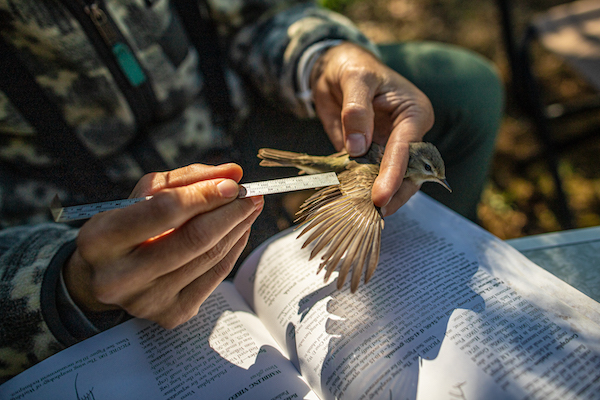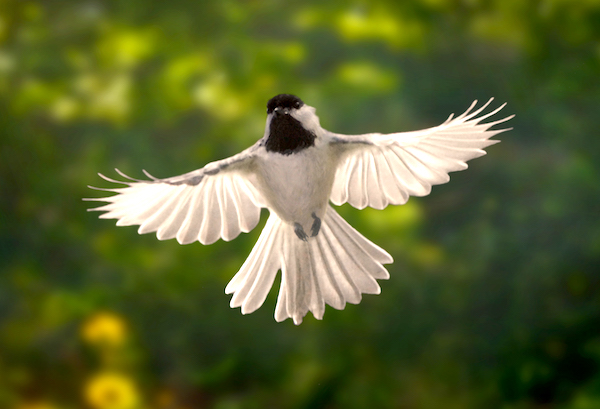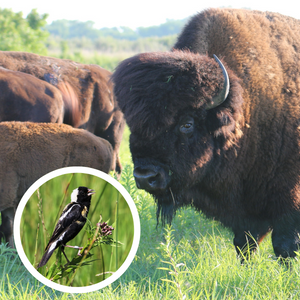The bodies of all living things are shaped by the physical environment, in response to temperature, precipitation, air pressure, and other factors, many of which are shifting due to climate change. Humans–the primary cause of climate change– are able to create artificial environments to evade much of this change, but most wild animals are not so lucky. Scientists are starting to see the effects of climate change on not only animal abundance, distribution, and behavior, but also on body size and form. For instance, climate change may be shrinking birds.

A vireo being measured at a MAPS station in Glacier National Park. Public Domain.
In a recent paper in Nature: Ecology and Evolution, Dr. Casey Youngflesh and colleagues from UCLA and IBP used data collected by the MAPS bird monitoring program between 1989 and 2018 to investigate how temperature and elevation affect the size and shape of birds. Using more than 250,000 banding records from 105 bird species, they found that within species, smaller body size was associated with warmer temperatures over space and time. Individuals breeding at lower latitudes are smaller, and as the climate warms, individuals at a given latitude are getting smaller over time. The researchers also found that within species, wing length increased in relation to body size as breeding elevation increased.
The 19th Century German biologist Carl Bergmann first posited that animals (particularly birds and mammals) are larger the closer to they live to the North and South Poles. His reasoning was that the environment is generally colder at higher latitudes and larger animals, with their lower surface area to volume ratio, better conserve heat. But does “Bergmann’s Rule” hold up in the real world?
Youngflesh and his co-authors found that within bird species, body size increased strongly with higher latitude (closer to the poles). But contrary to Bergmann’s rationale, they found the strongest effect of latitude on body size in species that experienced warmer temperatures at lower latitudes. This suggests that it is warmer temperatures and the ability to shed heat that drives the relationship between body size and latitude. Youngflesh has a hypothesis as to why warmer temperatures had a greater effect on body size:
In warm regions, birds might be close to what they find to be a tolerable temperature. That is, when temperature increases in these areas they need to do something about it. In colder regions, birds may be further away from these critical temperatures. So an increase in temperature in these areas might not be as much of a problem. As an analogy, if you’re a human out in 100-degree weather, an increase in temperature of 20 degrees could be quite dangerous. However, if you’re in 60-degree weather, that same increase isn’t going to be much of a problem.
The researchers also found that body size decreased over the course of the study in most species over the majority of North America. This is remarkable given that the study spanned just 30 years—an extremely brief time from an evolutionary perspective. This may mean that bigger birds are more likely to die at higher temperatures or that, during early developmental stages, individual birds can respond to the warmer environment by not growing as large. The results, while predicted, were still surprising to Youngflesh:
While we expect that birds should be responding to changes in the abiotic environment, it is always striking (if not surprising) to see that actually be the case. This is particularly true given that there are so many factors simultaneously acting on these animals. The consistent relationship between body size and temperature over both space AND time is not something that has been shown before, so this is quite exciting.

A Yellow-rumped Warbler in flight. Photo by C. Watts/Flickr.
These results have conservation implications as well. While species do seem to be adapting their body size to a warmer climate, body size responded more slowly over time than it did over space (latitude). This suggests that birds may not be changing their morphology quickly enough to keep up with the warming climate. “This point should be considered when we are thinking about the long-term persistence of species and how they are likely to cope with future climate change,” said Youngflesh. Populations and species of birds that already live in hot, arid environments may be especially at risk as climate warms because they are closer to their maximum tolerable temperatures.
In addition to temperature, the study also uncovered an interesting relationship between elevation and morphology: wing length within species increases with elevation. This is the first study to show wing length increasing independent of body size. So, it’s not simply that birds that breed at higher elevations tend to be larger and therefore have larger wings (in fact body sizes trend smaller as elevation increases.) Why would elevation affect wing length? Wings generate lift which allows birds to fly, but lift depends on air density which decreases at higher elevations. “We know that wings, whether attached to planes or animals, produce lower lift at higher elevations (due to lower air density there). But it was surprising that we see such a large effect,” said Youngflesh.
Studies like this one require long-term datasets that span a broad geographical space and include multiple species. Few wildlife datasets rival that of the MAPS program in terms of duration, geographic scope, and breadth of species studied. Youngflesh explained:
MAPS represents a critical resource for understanding not only how individual species vary over space but also how species are responding to the pressures of climate change. The program has incredible spatial coverage, spanning a large portion of the North American continent, and provides an incredible time series, dating back several decades. The scale of these data, collected at the individual level, allow us to understand and quantify variation within these species, which was a critical component of this work. MAPS is truly unparalleled in this regard. This research simply would not have been possible without the combined efforts of the many MAPS station operators that contribute to the project and the team at The Institute for Bird Populations.
If you are interested in watching a webinar on this study presented by Dr. Casey Youngflesh, you can do so on our website HERE or on IBP's YouTube Channel.






